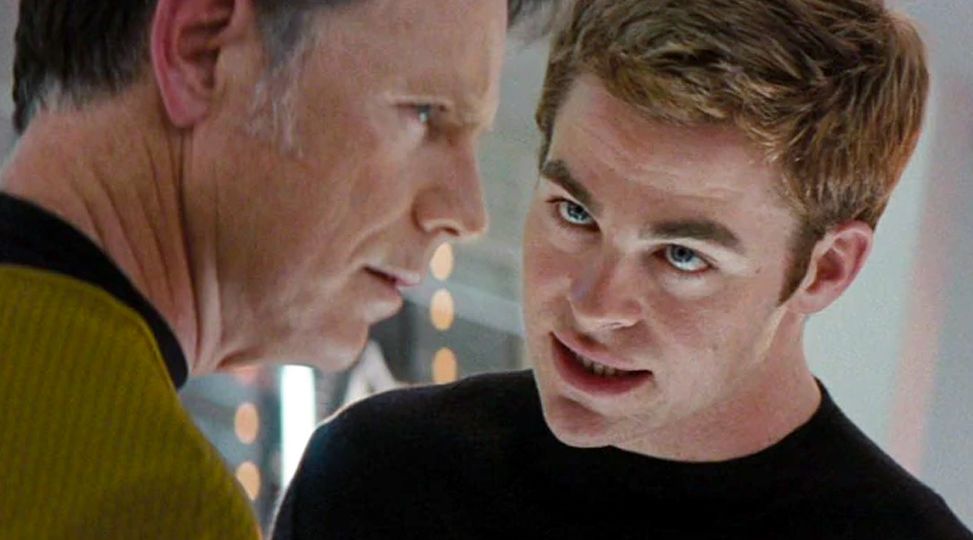
Becoming Captain Kirk
Susan Viglione, April 1, 2015

Analyzing Kirk’s Type
In assessing Kirk’s psychological type, I first looked for evidence of his preferred attitude type by considering whether his primary orientation is directed outward (extraversion) or inward (introversion). Jung (1921/1971) described the extraverted type as being consistently and routinely focused on what exists in the environment: “When a man thinks, feels, acts, and actually lives in a way that is directly correlated with the objective conditions and their demands, he is extraverted” (p. 333). Although he has subjective opinions, they are not primarily derived from introspection but rather in response to the objective situation; what he finds compelling, valuable, and interesting comes from without and by comparison the contents of his internal consciousness hold little attraction:
His interest and attention are directed to objective happenings, particularly those in his immediate environment. Not only people but things seize and rivet his attention …[and] objective happenings have an almost inexhaustible fascination for him, so that ordinarily he never looks for anything else. (1921/1971, p. 334)
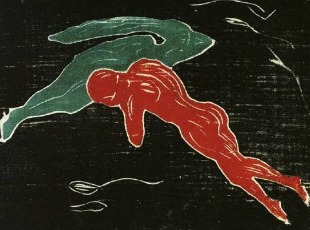
With these criteria in mind, I consider Kirk to be predominantly an extraverted type. He consistently demonstrates an attunement to the world around him, constantly registering and reacting to the outer situation with little to no pause for reflection. In an early scene, he is seated at a bar and in a matter of minutes makes a pass at a young female cadet and ends up in a brawl with four burly men. He repeatedly exerts himself to engage with others, often with mixed results, but the experiences seem to energize and motivate him, even when he ends up with a bruised and bloody body as a result. After he is defeated in the barroom fight, Captain Pike enters the scene and calls off the attackers, settles in to engage with Kirk, and offers fatherly advice. He suggests that Kirk could do more with his life than be “the only genius level repeat offender in the Midwest.” Pike compares Kirk to his father George Kirk, saying that he, too, “didn’t believe in no-win scenarios” and that he “had that instinct to leap without looking” (Abrams & Lindelof, 2009). Pike challenges Kirk to do better and invites him to enter Starfleet Academy to become an officer and eventually command a starship of his own. In a characteristically extraverted fashion, Kirk is next seen driving up to the launching location on a motorcycle. He hands the keys to a stranger and leaves his old life behind forever, apparently without a moment’s hesitation. Kirk is always alert to what is happening around him, picking up on chance remarks and noticing the details in his immediate environment that others might miss. Throughout, he is action oriented, fixed on the situation at hand, heedless of his physical condition, motivated by external stimuli, and largely unaware of his inner world.
With a solid hypothesis about Kirk’s preferred attitude being extraverted, I next considered his dominant and inferior functions. These make up what Beebe (2004) called the spine of the personality: “a vertical axis (between the superior function and inferior function) …defining the person’s conscious standpoint” (p. 92). According to Sharp (1987), we cannot determine the preferred attitude conclusively without also considering the dominant function to which it is attached: “It is not possible to demonstrate the introverted and extraverted attitudes per se, that is, in isolation. Whether a person is one way or the other only becomes apparent in association with one of the four functions” (pp. 13-14). To narrow the options, I looked at whether Kirk seems to act more from a rational and judging (Thinking or Feeling) or irrational and perceiving (Sensing or Intuiting) perspective. The rational functions have an orderly and predictable organization that leads from data to a conclusion: “Thinking and feeling are called rational because both are based on a reflective, linear process that coalesces into a particular judgment” (Sharp, 1987, p. 16). By contrast, the irrational functions are not oriented to a reasoning process; they take in the raw data as it is, fully formed: “The physical perception of something does not depend on logic—things just are. Similarly, an intuition exists in itself; it is present in the mind, independent of reason or a rational process of thought” (Sharp, 1987, p. 17). With this qualification in mind, it is apparent that Kirk is more of an irrational than a rational type. There is nothing remotely methodical about his approach to life; he reacts to the situation in the moment, operating on an instantaneous assessment of the facts and trusting his interpretation and conclusions without hesitation. He expends no effort on explanations unless forced to in order to convince others to follow his lead, but he would clearly prefer to simply direct rather than persuade.
Kirk has an exceptional ability to take in disparate data and connect the points into a pattern, enabling him to read a novel situation and accurately anticipate the adversary’s next move that nobody else can see coming. The first example of this talent occurs when Kirk realizes in a flash that the “electrical storm in space” that is reported to be occurring around the planet Vulcan is the same phenomenon described in a dispatch about a remote Klingon colony that was recently destroyed. The same phrase was used to describe the attack that had killed his father twenty five years earlier. Seeing the pattern clearly and in a flash of insight allows Kirk to realize that the Enterprise is about to stumble into a trap laid by the same enemy. When Kirk tries to tell Captain Pike of the danger, he must document the specific data-points upon which he based his conclusion, and only then is his argument deemed “logical.” This incident points to a dominant Perceiving type, rather than one that defaults to Judgment.
An effective way to determine which functions are more developed and operational is to examine how people deal with difficult situations: “Do they think their way out; do they wait for a hunch or an intuition; do they use observation or sensation to find loopholes; or do they try to solve the problem with feeling through another person?” (Wheelwright, 1982, p. 64). Kirk’s problem solving approach is exemplified in his response to the attack on Vulcan. It is clear that he is neither feeling into the situation through another person or thinking his way through in a methodical and logical fashion. Instead, he is combining the sensory information he has accumulated over time. Lieutenant Uhura’s overheard description of the attack on the Klingons and Kirk’s reading of Pike’s dissertation on the attack on his father’s ship come together in a sudden revelation of what it all means and what it implies about the current situation. There is no way to trace the process of his cognition because it happens all at once. Only afterward can he go back and superimpose a logical framework on his reasoning. Based on this analysis, it would appear that Kirk’s dominant function is either Sensation or Intuition, and whichever one of these is not the dominant must be the inferior function.
Wheelwright (1982) offered a clue to distinguishing which function is dominant and which is inferior, stating that the former is within the conscious control of the individual, and the latter seems instead to control the person: “The superior (developed) and inferior (undeveloped) functions are equally potent in everyone; but whereas the individual can rule the superior one, the inferior one inevitably rules the individual” (p. 64). Because it is preferred, the dominant function is likely to be most often used and therefore more highly developed than the other functions in the personality, while the inferior function, which cannot be employed at the same time as the dominant, falls into disuse and atrophies, remaining mostly undeveloped and therefore mostly outside of consciousness. For Kirk, it is not immediately apparent whether he uses his Sensing function first or last. It is central to his ability to produce accurate conclusions and insights, but it seems to be something that happens to him, rather than something he does. Wheelwright (1982) described extraverted sensation (Se) types as “realists,” inundated with objective data from the outer world, restlessly moving from one experience to the next, constantly seeking physical thrills and pleasure of the senses, pragmatic and flexibly adaptable to changing circumstances (pp. 64-65). By contrast, extraverted intuition (Ne) is described as a function that “operates when there are no facts, no moral guidelines, no proven theories, only possibilities and unknowns” (p. 66). This type will be at ease with impossible situations, paradox, and innovation, willing to take the most unconventional perspective to solving a problem without reliance on proven methods or received wisdom. They are also known for being disconnected from their bodies: “physically stoical, sometimes owing merely to unawareness” (p. 67). In both films we can see evidence of both extraverted sensation and intuition in Kirk at different times; in order to discern which is his dominant or superior function, we must look for what he tends to rely on most, what he does first, and what he has most fully developed.
In Star Trek into Darkness, Kirk is again in a position to render a radical interpretation of events and anticipate an enemy’s next move. He is in the company of Star Fleet’s senior leadership group as they review a recent bombing and evaluate what their response should be. With one ear tuned to the discussion in the room, Kirk focuses on the video of the event, zeroing in on the antagonist seen fleeing the scene. However, it is not the physical evidence that brings him to his startling conclusion, but rather some flash of insight. He suddenly knows that the bombing was just a ploy intended to trigger a gathering of Star Fleet Command in one room where they will be vulnerable to attack. This is an entirely intuitive leap that is not based on any perceptual data, coming out of nowhere fully formed into Kirk’s consciousness. As Sharp (1987) described it, “Intuitive thoughts come out of the blue, so to speak, as a hunch or a guess. …There is an extraordinary ability to sense what is going on behind the scenes, under the surface” (p. 59). Sharp further elaborated on the difference between extraverted sensation and intuition, stating that the former is oriented to an intense experience of the physical world and the latter is focused on generating multiple options: “Where extraverted sensation seeks the highest pitch of physical realism, extraverted intuition strives to apprehend the widest range of possibilities inherent in the objective situation” (p. 60), and whereas “Sensation types see only what is in front of them,” “Intuitives see the same scene transformed, as if in an inner vision” (p. 61). The former limit their scope to the concrete facts of outer reality and the latter translate these into a meaningful insight about what is really going on. Based on his knack for creative and startling insight together with his disregard for physical limitations, I conclude that Kirk’s superior function is extraverted intuition (Ne).
According to Haas and Hunziker (2011), Ne types are described as “driven to build future possibilities from the objective data in the environment,” to form “a series of verifiable links that create patterns and possibilities,” and to see “the patterns and connections that shape future alternatives” (p. 54). Those with dominant extraverted intuition use their observation of outer reality to form interrelated systems of information in an instant that coalesces into one or many visions of what could be; they are nonlinear in their thinking, oriented toward future possibilities, sometimes unfiltered or even indiscriminate in their evaluations of options, and often bored or chafed by structure and conventional ideas (pp. 54-56). Kirk is adept at finding innovative solutions to desperate situations that appear to have no chance of a positive outcome, and he is not averse to breaking the rules in order to beat the odds and achieve his goals.
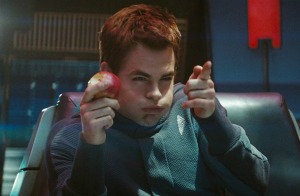
Having reached a provisional hypothesis that Kirk’s superior function attitude is extraverted intuition, it is necessary to observe what his auxiliary function may be in order to establish his four letter type code. If the dominant is an irrational function, then the auxiliary and tertiary functions will be rational (Sharp, 1987, pp. 19-20); that is, either Thinking or Feeling. Furthermore, as Beebe (2004) argues, the attitude alternates with each successive function, so that if the dominant function expresses as extraverted, then the auxiliary function will appear as introverted (p. 98). Beebe (2010) also theorized that the auxiliary function is geared toward caretaking of other people, unlike the functions on the “spine,” which are oriented primarily toward one’s relationship within the self (p. 74). The auxiliary function can be understood as normally the second most highly developed of the eight function-attitudes, supporting the activity of the dominant function, working in concert with it, and providing a balancing energy to it. Assuming that Kirk’s superior function is Ne, his auxiliary would have to be either introverted feeling (Fi) or introverted thinking (Ti). Marshall (1968) distinguished thinking from feeling, both judging functions, as a matter of describing versus interacting with reality: “Thinking is concerned with efforts to describe or represent realities; feeling is concerned with efforts to influence or interact with realities” and further, “any proposed representation of a reality is a hypothesis; any proposed interaction with a reality is a maneuver or strategy” (p. 7). Thinking is about defining and feeling is about valuing (Beebe, 2006, p. 132).
Kirk is much more given to evaluating situations, people, and things than he is likely to spend time in analysis or classification. He has a talent for assessing other people’s motives and understanding what drives them, using empathy indirectly as a strategic tool. Because Kirk can relate to the anguish of a villain such as Nero (Abrams & Lindelof, 2009), or Khan (Abrams, Burk, Lindelof, Kurtzman, & Orci, 2013), both of whom are acting out of revenge for the annihilation of their own people, he can see the world enough through their eyes to play a game of manipulation with them, provoking them where they are vulnerable, and anticipating their next moves. These qualities strongly suggest that Kirk has developed his introverted feeling function more than thinking. Further evidence for this conclusion can be drawn from the Fi type’s dependence on a subjective system of values and beliefs that override and take precedence over conventional principles and standards: “They trust and rely upon their unique framework of internally synthesized concepts, principles, and knowledge” (Haas & Hunziker, 2011, p. 84). Kirk has a tendency to justify his own actions by appealing to a higher order of morality, an internal archetype of what is true and right, especially when this conflicts with the rules and regulations. An example of this can be seen in his defense that because the Academy test is itself a cheat, intended to be impossible to pass, it is therefore legitimate to cheat the test.
Hillman (2013) summarized the Feeling function as one that “relates subject to object, to the contents of one’s psyche as values, and to one’s subjectivity as general feeling tone and mood” (p. 112). In other words, the Feeling function is what binds things and people together in a value based relationship; everything is judged for its worth, and for the introverted feeling type, the worth is subjectively determined and compared to an inner standard, not an outer one. Based on Kirk’s preference and more developed faculty of Feeling over Thinking, I propose that his personality type code is ENFP, and this would establish the positions of the first four function attitudes in the following order: extraverted intuition (Ne), introverted feeling (Fi), extraverted thinking (Te), and introverted sensation (Si).
Integrating Shadow
Although it is the least developed of the functions available to consciousness, the inferior function nevertheless plays a significant role in the personality. Von Franz (In Hillman & von Franz, 2013) described in detail the qualities that the inferior function possesses: it is slow, emotionally charged, unadapted, foolish, and ridiculous (pp. 16-21). Sharp (1987) calls it primitive, troublesome, and infantile (p. 23), and Jung (1953/1966) wrote, “The essence of the inferior function is autonomy: it is independent, it attacks, it fascinates and so spins us about that we are no longer masters of ourselves and can no longer rightly distinguish between ourselves and others” (para. 85). Taken together, these attributes describe the problematic impact of the inferior function on the personality. With introverted sensation as his inferior function, Kirk may be expected to struggle with insecurity and deficiency in the area of physical sensate reality, details, and relating past events to the present moment. This aspect of Kirk is revealed in his rather comical physical antics, his relentless pursuit of women for sex that is often rejected or ignored, his habit of turning to alcohol and picking fights when he is bored, depressed, or frustrated, and his refusal to acknowledge the wounds and bruises suffered by his body through each adventure. Several times in both films Kirk finds himself clinging to a ledge, hanging on by just his fingertips, until he can claw his way back up onto solid ground; this image reflects his essential vulnerability mixed with the indomitable spirit and determination to survive and carry on the fight.
Although it often manifests negatively, the inferior function is valuable in that it offers a portal to the shadow part of the personality. Von Franz (In Hillman & von Franz, 2013) made the case that the inferior function is the gateway to the unconscious, acting as a bridge to the symbolic realm (p. 16): “The inferior function is so close to the unconscious and remains so barbaric and inferior and undeveloped that it is naturally the weak spot in consciousness through which the figures of the unconscious can break in” (p. 44). Beebe elaborated on this idea by referencing the practice of Jungian analysts to view the inferior function as the “carrier” of the Anima or Animus, understood here as the contrasexual principle that represents the soul in the psyche. As such, it does not itself represent a shadow function but rather serves as the crossover to the true shadow functions: “It is the other four functions, I believe, that constitute the shadow of the first four, a shadow accentuated by the process of differentiation that allows the first four to develop and become conscious function-attitudes” (Beebe, 2006, p. 141). This process is essential to the project of becoming whole, integrating the conscious with the unconscious parts of the personality. As Beebe put it: “One way to understand what Jung meant by individuation is the progressive differentiation of the various psychological functions of consciousness” (p. 138). However, to truly individuate, it is necessary to delve into the unconscious realm and learn to recognize the shadow aspects of the psyche.
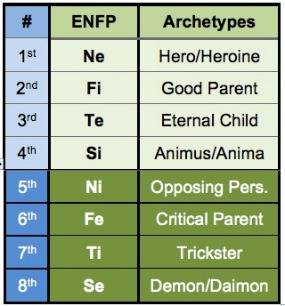
The archetype of Witch/Senex (aka the Critical Parent) applies to Kirk’s extraverted feeling (Fe) function-attitude in the 6th position. The Witch/Senex function is described as manipulative in service to its own agenda, capable of identifying and attacking other people exactly where they are most vulnerable and weak, and critical of both one’s own and others’ capacities as caretakers (McAlpine, et al., 2009). As with the Opposing Personality, the Witch/Senex may be most visible in a projection on another person, in this case Admiral Marcus. Marcus speaks to Kirk in a fatherly way, calling him son, but it is just a masquerade for his condescending and dismissive attitude toward the younger captain whom he clearly sees as immature and easily manipulated. Marcus has a covert and self-serving agenda to start a war with the Klingon Empire, and he uses Kirk’s loyalty to Pike, playing off his grief and loss to set Kirk up to commit an act of aggression that will ignite an armed conflict. When the Senex is channeled through extraverted feeling, it has an uncanny ability to pinpoint the area of greatest emotional vulnerability and launches a target attack where it will hurt and demoralize the subject the most (McAlpine, et al., 2009). We can see this dynamic at work when Kirk thwarts Marcus’ plan by adhering to the law and taking Khan into custody instead of killing him; Marcus berates Kirk for his naiveté, accusing him of being the reason that his entire ship and every crew member will be destroyed, twisting a knife in his wound of guilt and self-recrimination for not sufficiently protecting those under his command. This cuts Kirk to the bone because it echoes but distorts the lesson he was taught by his true father figure, Captain Pike. Kirk manages to withstand the blast from Marcus, and although his inflated self-confidence is shaken, he takes another step on the path to integrating his shadow by refusing to crumble or compromise. By witnessing the corruption of the admiral, Kirk gains some awareness of his own tendency to manipulate the facts to suit his agenda and begins to recognize the serious implications of that behavior.

As an unconscious function, the Trickster may also show up in projection on another person; this is most clearly exhibited in Khan, a complex and at times ambiguous character who mirrors many aspects of Kirk’s own personality, though in a distorted and exaggerated way devoid of Kirk’s ingrained morality. Like Kirk, Khan is deeply motivated by his mission to protect his crew, a small number of men and women who had been genetically modified and bred to be superior to humans in every way. This was an ancient experiment gone wrong. When this group of super beings sought to eliminate the human race for their inferiority and primitive violent natures, they were condemned to eternal imprisonment in cryogenic tubes. Khan had been revived by Admiral Marcus as a powerful tool to advance his plans of aggression against the Klingons, but Khan betrayed and used Marcus in order to free his people. This is a motive that Kirk can understand and even empathize with to some degree, but Khan takes it to a violent and destructive extreme, stopping at nothing to achieve his goals and behaving utterly without mercy. Khan acts in a Trickster role by playing with Kirk’s insecurities and urge for revenge, telling him the truth about Marcus’ plans, and even collaborating with Kirk to defeat the Admiral; he magnifies and manipulates Kirk’s own propensity for ethical acrobatics to justify and defend his righteous agenda. Kirk finds himself in a highly risky situation of needing to trust Khan in order to secure his assistance to defeat their common foe, but knowing that once that is accomplished, Khan will inevitably turn on him to destroy the Enterprise. Kirk tries to out-trick the ultimate Trickster in Khan, and fails, nearly losing the Enterprise, her crew, and his own life in the process.
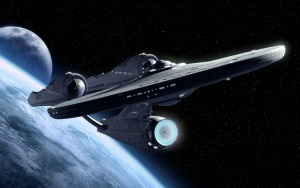
Kirk’s confrontation with the archetype of the Demon, extraverted sensation (Se) in the 8th position works to bring Kirk to the brink of despair and undermines all of his ego strengths at their core. Buried at the farthest reaches of the unconscious, the archetype in this position is experienced as “alien,” “uncontrollable,” or “nonexistent” (McAlpine, et al., 2009); it has an impersonal quality, manifesting as an inexorable and crushing force relentlessly bearing down to destroy the Enterprise and her crew. Khan can also be seen as the carrier of this energy once he appears to have been outmaneuvered by Kirk and Spock. When he realizes he has failed to secure the freedom and safety of his people, he devolves into a maniacal and elemental embodiment of pure evil with a blind rage fixated on annihilation. We have seen aspects of this behavior in Kirk also, at times when his righteous fury and wounds of loss have led him to lose his humanity and descend into brutish violent behavior that takes control of him and overcomes his higher nature with a drive for vengeance and destruction. At the climax of the film, this side of Kirk appears to be externalized and channeled through Khan. When it appears that all is lost and the Enterprise is about to disintegrate as it plummets into Earth’s atmosphere, Kirk loses the last vestige of his brash self-confidence and hands over command to Spock, saying, “I have no idea what I’m supposed to do. I only know what I can do.” Left with nothing but his own determination to do everything in his power to save the ship and crew, Kirk transcends the Demonic archetype and breaks through to the Daimonic aspect of extraverted sensation: He uses his body to realign the power grid and save the ship and crew, sacrificing his own life in the process.
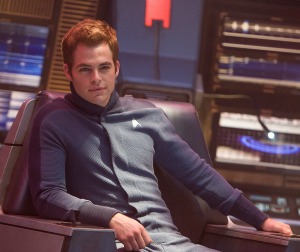
There will always be those who mean to do us harm. To stop them, we risk awakening the same evil within ourselves. Our first instinct is to seek revenge when those we love are taken from us. But that’s not who we are. …When Christopher Pike first gave me his ship, he had me recite the Captain’s Oath. Words I didn’t appreciate at the time. But now I see them as a call for us to remember who we once were and who we must be again. And those words: Space, the final frontier. These are the voyages of the starship Enterprise. Her five-year mission: to explore strange new worlds, to seek out new life and new civilizations, to boldly go where no one has gone before. (Abrams, Burk, Lindelof, Kurtzman, & Orci, 2013)
Using psychological typology to trace the arc of Kirk’s development from brash, playful, brilliant, but irresponsible boy to seasoned veteran with a greater understanding of his own strengths and vulnerabilities provides a vivid illustration of the power of understanding type in all its guises, recognizing the expression of ego-syntonic and -dystonic function-attitudes through the archetypes. It is a powerful tool for growth and personal development—to explore strange new inner worlds, and assist in achieving one’s highest potential and living one’s life purpose with integrity and authenticity, our true “final frontier.”
References
Abrams, J. J. & Lindelof, D. (Producers), & Abrams, J. J. (Director). (2009). Star trek [Motion picture]. USA: Spyglass Entertainment & Bad Robot Productions.
Abrams, J. J., Burk, B., Lindelof, D., Kurtzman, A., & Orci, R. (Producers), & Abrams, J. J. (Director). (2013). Star trek into darkness [Motion picture]. USA: Bad Robot Productions & Skydance Productions.
Beebe, J. (2004). Understanding consciousness through the theory of psychological types. In J. Cambray, and L. Carter (Eds.), Analytical psychology: Contemporary perspectives in Jungian analysis (pp. 83-115). Hove, UK: Brunner-Routledge.
Beebe, J. (2005). Evolving the eight-function model. Association for Psychological Types Bulletin, Winter, 2005, 34-39. (Reprint 2006, Australian Psychological Type Review 8(1), 39-43).
Beebe, J. (2006). Psychological types. In R. Papadopoulos (Ed.), The handbook of Jungian psychology: Theory, practice, and applications (pp. 130-141). London, UK: Routledge.
Beebe, J. (2010). The recognition of psychological type. In M. Stein (Ed.), Jungian psychoanalysis, (pp. 71-80). Chicago, IL: Open Court.
Haas, L. & Hunziker, M. (2011). Building blocks of personality type: A guide to discovering the hidden secrets of the personality type code. Temecula, CA: TypeLabs.
Hillman, J. & von Franz, M.L. (2013). Lectures on Jung’s typology. Dallas, TX: Spring Publications.
Jung, C. G. (1921/1971). General description of the types. In H. Read, M. Fordham, G. Adler, & W. McGuire (Eds.), The collected works of C. G. Jung (R. F. C. Hull, Trans.) (Vol. 6, pp. 330-407). Princeton, NJ: Princeton University Press. (Original work published 1921)
Jung, C. G. (1953/1966). Two essays on analytical psychology (2nd ed.) (R. F. C. Hull, Trans.) Princeton, NJ: Princeton University Press.
Jung, C. G. (1959/1979). Aion: Researches into the phenomenology of the self. (R. F. C. Hull, Ed & Trans.). The collected works of C. G. Jung (vol. 9, pt. 2). Princeton, NJ: Princeton University Press. (Original work published 1951)
Marshall, I. N. (1968). The four functions: A conceptual analysis. Journal of Analytical Psychology, 13(1), 1-32
McAlpine, R., Shumate, C., Evers, A., & Hughey, D. (2009). The Function-Archetype Decoder [Software program]. Louisville, KY: Type Resources.
Sharp, D. (1987). Personality types: Jung’s model of typology. Toronto, Canada: Inner City Books.
Shumate, C. (2011). Shadow boxing with Fight Club. In Personality Type in Depth, December 2011, Issue #8.
Wheelwright, J. B. (1982). Psychological types. In St. George and the dandelion (pp. 53-77). San Francisco, CA: C. G. Jung Institute of San Francisco.
Header Image
Kirk Warning Pike











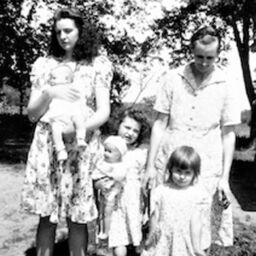






Nice article! im an enfp myself maybe that’s why i identify with kirks character. would you say the original capt kirk (william shatner) is very similar?
Superb article. I am a huge Star Trek fan so I am so glad that someone finally applied Jungian typology to Star Trekology. Your typological assessment of CPT Kirk (Chris Pine version) is obviously though out, however, as a Trek classicist, I would have pegged Kirk as an ENTP. Kirk’s extraverted intuition, as evidenced by his ability to quickly size up a high context situation and and make an on the spot decision. This is ENTP. Granted, Kirk does care about people, in particular his crew, however, this seems subordinate to his introverted thinking. If Kirk were an ENTP, extraverted feeling would be his tertiary function. Jung’s introverted decision making is evidenced by his inner focus on logical analysis and sense of internal precision in his thought process. Again, this may be more applicable to the William Shatner Kirk. Chris Pine’s version’s typology seems a little different and he very well could be an ENFP as you suggest. Either way, I really enjoyed your article. Thanks for finding the time to write about something I enjoy.
Cool article. I think two points you brought up are worth highlighting, just because I think they’re often lost points and pretty subtle.
(1) You bring up that not just intuition, but all irrational functioning, is often at a loss for logical explanation. The stereotype is only the introverted and extraverted intuitives come up with things that seem instinctual impressions out of the blue, but the reality as far as I see is that the logical regularization sought by rational functioning to put not just coherency but consistency and definition around irrational absolute experience is opposed quite a bit to sensation, if properly viewed as an irrational mode of experience.
I think of, say, your typical person in a an ancient society, who might know the way about various neighborhoods without logically representing the path they take, say in a structured map or such – with a real, down to earth connection to the physical cues. They also appear to “just know,” but the links are not unconscious, but physical (the former would be in intuition).
The case where it’s easy to really string together the links into explanation is when the physical is abstracted into logical form.
(2) The idea that thinking and feeling differ by “interaction” vs “description” (I’d have said in my own words as “involvement” vs “representation”) is also pretty key – I’d say feeling is the function by which the human involves himself or herself in the situation, and where that involvement is key and integral to the certification of whatever determination one is making, as “rational.”
Involvement, relatedness, whatever you call it — there is a mental aspect to that involvement/relatedness which is what evokes the feeling tones evaluated by the function.
I should note feeling tones also arise through physical involvement, which is a less mental form of relatedness, more physical, and probably the one Jung notes most philosophers attribute feeling to (i.e. most call it essentially identical with sensation).
Likely this is the kind of less differentiated feeling that Jung detailed in Schiller, in Psychological Types, and the kind he was trying to differentiate the feeling function from.